July in the Grand Canyon
Learn all about what it means to visit Grand Canyon National Park in July
Updated: 10/26/22
July in Grand Canyon National Park is a flourishing, lively time to be there with clear, bright mornings and often thunderstorms in the afternoons and evenings. It’s an excellent month for camping at the South Rim and the North Rim, evening photography, for white water rafting, and for hiking as long as you get early starts. It’s a popular time of year to be at the rims, less popular at the bottom of the Canyon because of the midday heat.
Benefits of Visiting in July
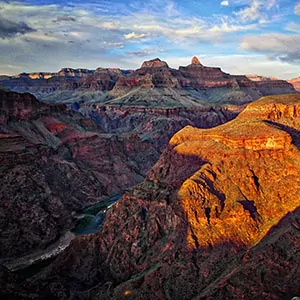 One major benefit of visiting the Grand Canyon in July is excellent temperatures for camping on the rims. This beautiful section of the park is much more remote than the touristy South Rim and receives only about 15% of the park’s total visitors. The North Rim Campground is wonderful in July, where you camp beneath pine and aspen trees not far from the rim. Visitors have a great chance of seeing wildlife in July on the north rim, as the pleasant temperatures bring the animals out and about. The bison only live on the North Rim and the lack of crowds will make seeing other creatures easier.
One major benefit of visiting the Grand Canyon in July is excellent temperatures for camping on the rims. This beautiful section of the park is much more remote than the touristy South Rim and receives only about 15% of the park’s total visitors. The North Rim Campground is wonderful in July, where you camp beneath pine and aspen trees not far from the rim. Visitors have a great chance of seeing wildlife in July on the north rim, as the pleasant temperatures bring the animals out and about. The bison only live on the North Rim and the lack of crowds will make seeing other creatures easier.
South Rim camping is also fantastic, and there are several campground options. While this side of the park will be on the busier side, it also has many famous sites. The pleasant, mountain summer weather makes the rims excellent for sightseeing, photography, biking, or other tours. While the park is famed for its heat (rightly so inside the canyon), the rims are mountainous, Alpine environments, and visiting in summer would be much like visiting Yosemite in summer. See more about Grand Canyon camping or all-inclusive hiking and camping tours.
Another benefit of July is commercial white water and still water rafting is open. The very hot temperatures inside the canyon make these activities popular, as the frigid waters of the Colorado River feel refreshing in the 100°+ heat. Rafting tours vary wildly in length from a single day to 18 days.
July is also fantastic for photography. The beginning of the monsoon season in Arizona where afternoons and evenings often bring thunderstorms, some people might expect these thunderstorms to halt activities. While it’s true that afternoon showers can interrupt some of your plans, they are excellent for photography as the majestic canyon set beneath lightning and dark clouds make for amazing pictures.
The heat inside the canyon makes most of the crowds stay up on the rims and thus reservations at Phantom Ranch, are much easier to come by. This sought-after accommodation on the floor of the canyon is booked months in advance, but in the heat of summer and in the cold of winter you might be able to find reservations on shorter notice.
July also brings robust tour options because of the larger crowds in the busy summer season. Many of these tours are a great way to escape some of the crowds in the very populated parts of the park and get out on your own while staying safe with an expert guide.
Drawbacks of Visiting in July
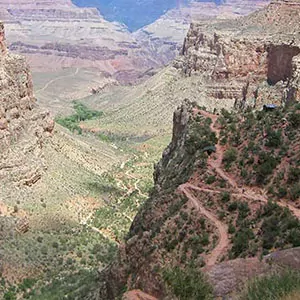 The major drawbacks of visiting in July are the sweltering summer temperatures inside the Canyon. July is one of the hottest months of the year, and heat in the canyon is no joke. Temperatures often exceed 105° and have been known to reach up to 120°F. This makes backpacking and hiking difficult, uncomfortable, and dangerous. Rangers treat many cases of heat exhaustion a day, alongside the more life-threatening heat stroke.
The major drawbacks of visiting in July are the sweltering summer temperatures inside the Canyon. July is one of the hottest months of the year, and heat in the canyon is no joke. Temperatures often exceed 105° and have been known to reach up to 120°F. This makes backpacking and hiking difficult, uncomfortable, and dangerous. Rangers treat many cases of heat exhaustion a day, alongside the more life-threatening heat stroke.
If you plan on doing any hiking in the canyon, prepare to start before sunrise and be off the trail before 11 am. If you’re doing a longer hike, you will need to sit out the midday heat and start hiking in the “cooler” afternoons when it’s only 100°F.
In contrast to June, the heat of July in the Grand Canyon is often mitigated by afternoon monsoons and thundershowers. Although these events may cool you off and lessen the heat, they come with their own dangers of flash floods and making the steep trails muddy and slippery. The potential for flash floods is a drawback. For most visitors to the park, the rains and possible flash floods simply cancel activities; you can’t hike on a trail that’s washed out. However, for those backpacking in the canyon or rafting the Colorado River, flash floods can pose a more significant danger. For backpackers, flash floods can wash out essential trails, block your exit route, or wash away your campsite including all your gear and possibly yourself. For rafters, flash floods can cause rapids to be more treacherous, side hikes to be washed away, and the potential to be washed away yourself. Despite all the dangers of flash floods pose, these floods are genuinely amazing to watch, if you’re from a safe distance. It will be the highlight of your trip to see one of these amazing floods rushing through in a smaller version of what possibly originally formed the Grand Canyon.
Another of the obvious drawbacks of July is the crowds. If you think going when the mid-summer heat is the most intense would keep the crowds away, you are unfortunately incorrect. July is one of the most popular times in the park and you can expect long waits for shuttles, roads that are congested with traffic, and extensive lines for services. The crowded summer season also brings higher accommodation rates and lower accommodation availability. If you’ve ever tried to plan a last-minute summer trip to the Grand Canyon, you’re probably aware of how far out the park books in advance. Last-minute travelers may have to stay hours outside the park to find something that is available.
The North Rim can provide some relief from crowds, but it does not have many of the famous sites, as many campgrounds or accommodation options, or as many trail options as the South Rim. To maximize your time, not have to worry about reservations, transportation, or hiking safely in the Canyon in the summer, consider joining a Grand Canyon hiking tour. The expert guides on these tours will make sure that you are not missing any essential safety information and will know what to do if a dangerous situation arises. With itineraries and logistics, all planned out, all that’s left for you to do is to relax and enjoy your trip.
Things to Do in July
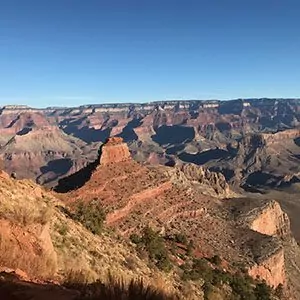 There are nearly endless things to do in July in Grand Canyon depending on what you’re interested in and how much experience you have. If you plan far enough in advance, a whitewater rafting trip is a great choice for July. Getting soaked by the cold water of the Colorado River is a wonderful thing in the heat of the summer at the bottom of the Canyon. Multi-day rafting tours and single-day rafting tours are available. As mentioned above, camping on the rims is excellent in July, especially if you’re planning to stay on the rims where the temperatures are pleasant throughout the day and just chilly enough at night to crawl into your sleeping bag.
There are nearly endless things to do in July in Grand Canyon depending on what you’re interested in and how much experience you have. If you plan far enough in advance, a whitewater rafting trip is a great choice for July. Getting soaked by the cold water of the Colorado River is a wonderful thing in the heat of the summer at the bottom of the Canyon. Multi-day rafting tours and single-day rafting tours are available. As mentioned above, camping on the rims is excellent in July, especially if you’re planning to stay on the rims where the temperatures are pleasant throughout the day and just chilly enough at night to crawl into your sleeping bag.
Hiking is an option in July, but you will need to start before sunrise and be back out of the canyon before mid-day for safety reasons. If you find yourself at the bottom of the canyon in the heat of the day, wait. Coming back out of the canyon can take twice as long as hiking down and you do not want to make the trek on the steep trails in the mid-day heat. Hiking outside the Corridor trails (South Kaibab, North Kaibab, and Bright Angel Trails) is not recommended in the summer. Backpacking can be done in July, but if you lack summer hiking experience in desert environments we recommend going with a backpacking guide company to safely navigate the heat of the Canyon. Heat exhaustion, heat stroke, water poisoning, flash floods, lightning strikes, wildlife danger, and many other risks come with being in the backcountry in the Grand Canyon, so you’ll want to make sure you know what you are doing or are with someone who does.
If you’re an avid photographer we heartily recommend checking the weather report, and if monsoons are forecast, setting up at one of the viewpoints to get stunning shots of thunderstorms over the Canyon. These fantastic storms over the canyon are some of the most sought-after photography shots with the crimson and copper rocks as a foreground to lightning and dark clouds. Be aware of your surroundings, however, as lightning strikes at rim viewpoints happen frequently. If lightning is less than 5 miles away (five seconds between the lightning flash and a thunderclap equals 1 mile of distance), you are in danger of being struck by lightning and should take shelter. Move away from the rim of the canyon, avoid open spaces and tall trees, and do not touch any metal railings or the metal on vehicles.
Since the weather is so inclement in July, you may need some indoor activities to wait out the storms or the heat. The Yavapai Geology Museum which has fantastic exhibits on fossils and geology in the park or the Kolb Studio and photo gallery are great options for indoor activities. The visitor centers on both the South Rim and North Rim are great and have an excellent, 22-min film about the park and the surrounding area that will be informative and also entertain the kids. If you have a whole day to spend, a trip on the Grand Canyon Railway from the nearby town of Williams is a fantastic way to spend the day taking you back in time to the days of train travel and outlaws. Native American and early settler history is also available to see in the park at the Tusayan Museum and Ruin, Eagle Point Native American village on the west rim, or the Desert View Watchtower to the east. There are nearly endless possibilities for activities in the park, so gear up for the adventure of your choice.
things to see in july
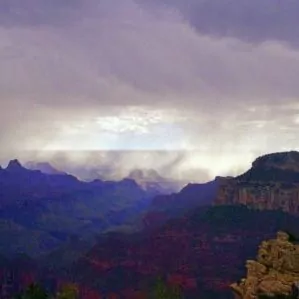 There are nearly as many things to see in July is there a to do, and if you read the previous section you know that’s a lot. Sightseeing is one of the most popular activities as hiking inside the canyon is extremely hot but the temperatures at the rims are pleasant. So if sightseeing is the main item on your agenda, rest assured that you won’t be bored. Below, we’ve compiled a list of some of the must-see sites in July, but make sure to do your own research to see what piques your interest in the park as this list is by no means exhaustive.
There are nearly as many things to see in July is there a to do, and if you read the previous section you know that’s a lot. Sightseeing is one of the most popular activities as hiking inside the canyon is extremely hot but the temperatures at the rims are pleasant. So if sightseeing is the main item on your agenda, rest assured that you won’t be bored. Below, we’ve compiled a list of some of the must-see sites in July, but make sure to do your own research to see what piques your interest in the park as this list is by no means exhaustive.
Desert View Watchtower: Positioned towards the east entrance of the park, this watchtower seems to rise out of the very canyon walls itself. The work of the famous park architect Mary Colter, this tower is visitors’ first opportunity to see the canyon and glimpses of the Colorado River if they’re entering from the east entrance. With a Native American Kiva recreation on the bottom level and windows out for Canyon views on the upper levels, this tower is definitely worth a climb.
Thunderstorms: July and August are famous in the Grand Canyon for thunderstorms as the monsoon season in Arizona begins to roll in. These violent storms over the canyon are fantastic to watch as long as you’re a safe distance away. Be aware of lightning strikes and flash flood dangers, but make sure you don’t miss seeing lightning flash over the canyon’s red rocks and feeling the power of the thunder shaking the walls.
North Rim: Receiving less than 15% of the total visitors to the park, the North Rim is not to be missed in July when it’s open for private vehicles to drive to. With many trails, a campground, and a visitor center, the North Rim gives you a much wilder and more remote experience than the touristy South Rim. Stroll along the rim trails and take in the views or go searching for wildlife such as bison and elk. It’s a long drive for being able to see it from the South Rim, but it is well worth it.
Yavapai Point: Located near the visitor center on the South Rim, this point offers some of the most panoramic views of the entire park. Great for sunrise or sunset, Yavapai Point is very popular, so make sure you go at a less popular time of the day. It’s also a great spot for viewing thundershowers if you want to try to take some pictures of these fantastic storms.
Hermit’s Rest: At the end of Hermit’s Rest Scenic Drive lies Hermit’s Rest, a reconstruction of an old miners’ cabin. Once again the work of Mary Colter, the building now contains a snack stand and gift shop. It was once the last piece of civilization that visitors saw before descending into the canyon via the trail that stretches west from this point. Make sure to spend some time here despite the busy shuttles as the views are simply fantastic.
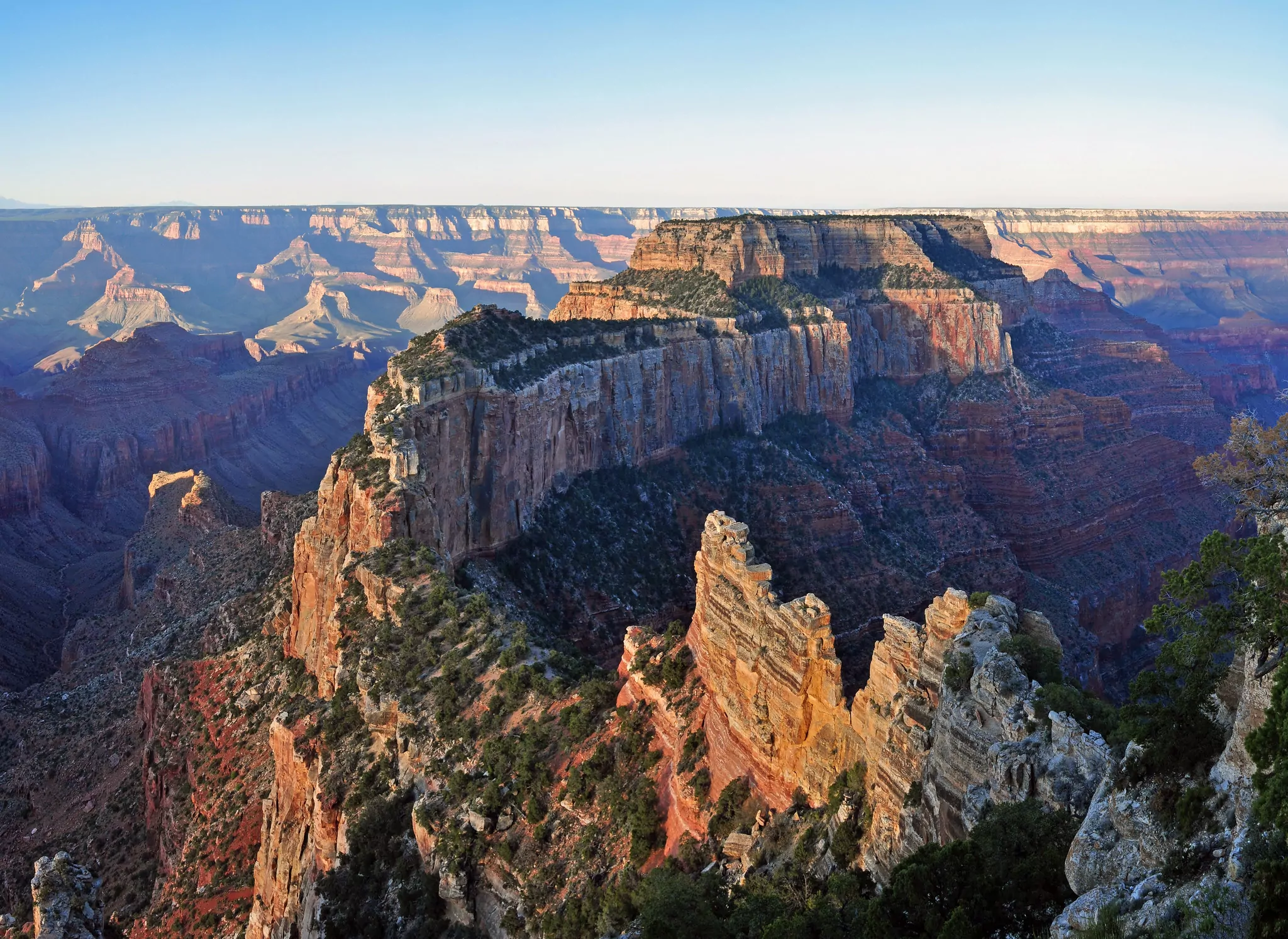
Hiking in July
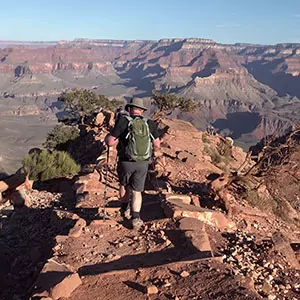 Hiking is a great activity in July, but there are some risks that hikers need to be aware of before they set out on the trail. The most obvious of these risks is the intense heat in the canyon. Every step that you descend from the rims becomes hotter and many inexperienced hikers are lured into dangerous situations by the initial downhill hiking and the cooler temperatures at the rim. Coming back up out of the canyon can take twice as long as hiking down, and you will use much more water. If you’re doing a day hike, it’s highly recommended to start very early (hiking by 5 am) and be off the trail by 10 am. Most guests that needed medical treatment from heat-induced conditions were hiking in the 11 AM to 4 PM range. Stick to Corridor Trails: South Kaibab, North Kaibab, and Bright Angel. Bright Angel is the safest summer trail in the Canyon because it has shade and water every 1.5 miles. If you’re hiking Rim to Rim in a day, consider starting your hike around 2 or 3 am, relaxing in the shade and creek water near Phantom Ranch from 10 am to 4 pm, and finishing your hike in the late afternoon/evening. The national park service does not recommend hiking rim to rim in one day any season, and doing a backpacking trip with a single night at the bottom of the canyon is a much safer option. You can see NPS’s Summer Hike Smart Tips for more information on hiking safely in the summer.
Hiking is a great activity in July, but there are some risks that hikers need to be aware of before they set out on the trail. The most obvious of these risks is the intense heat in the canyon. Every step that you descend from the rims becomes hotter and many inexperienced hikers are lured into dangerous situations by the initial downhill hiking and the cooler temperatures at the rim. Coming back up out of the canyon can take twice as long as hiking down, and you will use much more water. If you’re doing a day hike, it’s highly recommended to start very early (hiking by 5 am) and be off the trail by 10 am. Most guests that needed medical treatment from heat-induced conditions were hiking in the 11 AM to 4 PM range. Stick to Corridor Trails: South Kaibab, North Kaibab, and Bright Angel. Bright Angel is the safest summer trail in the Canyon because it has shade and water every 1.5 miles. If you’re hiking Rim to Rim in a day, consider starting your hike around 2 or 3 am, relaxing in the shade and creek water near Phantom Ranch from 10 am to 4 pm, and finishing your hike in the late afternoon/evening. The national park service does not recommend hiking rim to rim in one day any season, and doing a backpacking trip with a single night at the bottom of the canyon is a much safer option. You can see NPS’s Summer Hike Smart Tips for more information on hiking safely in the summer.
The best way to prevent serious heat-induced conditions while hiking in July is not to hike when it’s hot. As stated above, day hikes should start before sunrise and finish before midday. If you find yourself in a situation where you are beginning to climb out of the canyon in the heat of the day, wait. It is worth waiting a few hours for the heat to subside instead of risking illness to climb out. It is recommended to keep a flashlight in your pack so that you can have the option of hiking in the dark if a situation has kept you longer than you anticipated. It is important to know the difference between heat exhaustion and heat stroke as the latter is a medical emergency and needs immediate treatment.
Dehydration is a significant threat as inexperienced hikers don’t bring enough water for the amount of sweat they will be losing in the intense heat. This is often due to the fact that rim temperatures are much cooler than in the canyon and those who are not experienced will be fooled into thinking the canyon will be the same temperature. On the other side of the spectrum, water poisoning can affect visitors who drink too much water and don’t carry food to eat while on the trail. Also called water intoxication, this condition occurs when an excess of water creates a sodium imbalance in the bloodstream causing cells to swell with water. If this happens in the brain, it can be life-threatening, so make sure to bring salty snacks and eat regularly while you are on the trail. For those wanting to hike in the summer, it is highly advisable to go with a guiding company, even on just a day hike to make sure you have a certified, expert guide who is accustomed to hiking in the region and will know how to react in an emergency situation.
backpacking in july
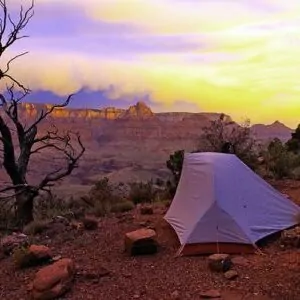 July is one of the hottest months in the Grand Canyon which makes backpacking feasible but more dangerous. If you’re interested in a backpacking trip, consider joining a guided trip to maximize your safety and comfort. The expert guides make sure you aren’t missing any essential safety information and will know how to react in a dangerous situation, should one arise. Because of the intense heat, trekking with a full backpack needs to be limited to morning and evening hours. The extra weight on your back will cause more sweating and loss of water and salt, so you will need to carry more water and food than you might otherwise. Besides the heat, July poses dangers of flash floods, rock falls, and lightning strikes as the monsoon season arrives with frequent afternoon thundershowers. It is important to understand the dangers of these and how to best keep yourself safe. Anything beyond a rim-to-rim backpacking trip on the corridor trails should not be attempted on your own in Grand Canyon unless you are an experienced desert hiker. If you want to do a longer trip, consider booking a trip with a guiding company that will take care of much of your gear, itinerary, and all the safety logistics. Summer in Grand Canyon is not to be laughed at and comes with some serious dangers, but it can be rewarding if you are willing to put in the work to make sure your trip is safe and enjoyable.
July is one of the hottest months in the Grand Canyon which makes backpacking feasible but more dangerous. If you’re interested in a backpacking trip, consider joining a guided trip to maximize your safety and comfort. The expert guides make sure you aren’t missing any essential safety information and will know how to react in a dangerous situation, should one arise. Because of the intense heat, trekking with a full backpack needs to be limited to morning and evening hours. The extra weight on your back will cause more sweating and loss of water and salt, so you will need to carry more water and food than you might otherwise. Besides the heat, July poses dangers of flash floods, rock falls, and lightning strikes as the monsoon season arrives with frequent afternoon thundershowers. It is important to understand the dangers of these and how to best keep yourself safe. Anything beyond a rim-to-rim backpacking trip on the corridor trails should not be attempted on your own in Grand Canyon unless you are an experienced desert hiker. If you want to do a longer trip, consider booking a trip with a guiding company that will take care of much of your gear, itinerary, and all the safety logistics. Summer in Grand Canyon is not to be laughed at and comes with some serious dangers, but it can be rewarding if you are willing to put in the work to make sure your trip is safe and enjoyable.
Weather in July
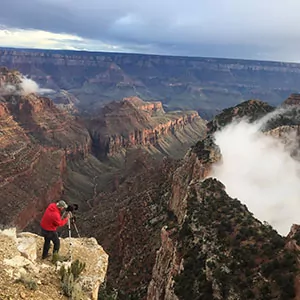 Grand Canyon is a large park and the main feature, the canyon itself, means that the weather you will experience will depend greatly on your elevation and location in the park. As we have already mentioned, the rims of the canyon are mountainous environments that have snow storms in the winter but we remain relatively mild in the summer. At the bottom of the canyon, however, is a desert environment that remains relatively pleasant in the winter but can reach scorching heat in the summer. The average high at the South Rim in July is 85 degrees Fahrenheit, and the average low is 50 degrees Fahrenheit (high of 29 degrees Celsius, low 10 degrees Celsius.) At Phantom Ranch at the bottom of the Canyon, however, the average high temperature in July is 106 degrees Fahrenheit, and the low of 77 degrees Fahrenheit (41H/25L degrees Celsius). These numbers are ambient air temperature in the shade; it can feel much hotter in the sun. The average number of days of rain in July is 5. Visitors should keep in mind that these numbers are only averages and the park can be much hotter or colder than this. Temperatures in the canyon often exceed 110° with the highest ever recorded being 120°.
Grand Canyon is a large park and the main feature, the canyon itself, means that the weather you will experience will depend greatly on your elevation and location in the park. As we have already mentioned, the rims of the canyon are mountainous environments that have snow storms in the winter but we remain relatively mild in the summer. At the bottom of the canyon, however, is a desert environment that remains relatively pleasant in the winter but can reach scorching heat in the summer. The average high at the South Rim in July is 85 degrees Fahrenheit, and the average low is 50 degrees Fahrenheit (high of 29 degrees Celsius, low 10 degrees Celsius.) At Phantom Ranch at the bottom of the Canyon, however, the average high temperature in July is 106 degrees Fahrenheit, and the low of 77 degrees Fahrenheit (41H/25L degrees Celsius). These numbers are ambient air temperature in the shade; it can feel much hotter in the sun. The average number of days of rain in July is 5. Visitors should keep in mind that these numbers are only averages and the park can be much hotter or colder than this. Temperatures in the canyon often exceed 110° with the highest ever recorded being 120°.
July takes a turn away from its neighbor June in weather as it marks the beginning of the monsoon season in Arizona. This means that visitors should expect afternoon thundershowers quite frequently, at least once a week. These thundershowers, while amazing to watch from safe distances, can be dangerous. Lightning strikes happen on the rim nearly every year, rock falls can endanger hikers even on the corridor trails, and flash floods can sweep away gear, food, and people if you’re not careful. Read up on the National Park Service’s safety regarding these weather events.
Despite the rain, the heat in July still poses a significant threat and shouldn’t be treated lately. Rangers treat many cases of heat exhaustion a day, and the park typically has a couple of cases of heat stroke a year. Many visitors are lured into hiking by the initial downhill trek and the cooler temperatures at the rim. Do not be fooled. The heat intensifies with every step that you take further into the canyon and it will take at least twice as long to ascend back to the rim as it did to hike down.
Visitors should also keep in mind that the park is at elevation, with rims around 7,000 to 8,000 feet depending on your location. For those of us who live at or near sea level, the elevation can cause shortness of breath, increase sweating, and cause you to run out of energy sooner. If you’re at the park for a few days, you should acclimate to the elevation, but be aware of it as you plan your day’s activities. You might also find the air at the Grand Canyon to be very dry, especially if you’re used to a humid climate. This is partly due to the elevation and partly due to the desert environment. Bring lotion and lots of sun protection. As we talked about in the hiking section, heat exhaustion, heat stroke, and water poisoning are very real risks if you decide to hike into the canyon. If you are staying on the rims, particularly if you are camping, be aware of the dangers of hypothermia at night and bring layers to keep warm.
Always be sure to check the forecast before you set out for the day, especially keep your eye out for afternoon thundershowers. With so many different options, you are sure to find a place in this park where the weather suits what you’d like to do, whether it be bundled up around the campfire at night or getting drenched with freezing river water to cool down in the 100+ degree air.
wildlife in july
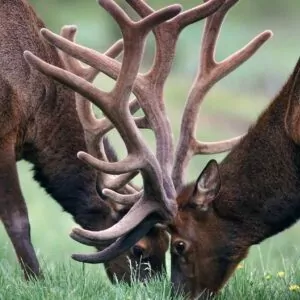 The Grand Canyon is brimming with wildlife and you have a good chance of seeing some if you go in July. While some of the animals will slow down during the day and become more active at dawn, dusk, and night because of the heat, you’ll still get chances to see some of these amazing animals. Reptiles and amphibians in the park will be out of hibernation and active during the summer months, so keep your eye out for gila monsters, rattlesnakes, and desert collard lizards. Some of the larger wildlife will also be active, especially on the North Rim where there are fewer crowds. You can see bison on the North Rim, and elk and deer on both rims. It is important to keep your distance from these animals, as they can be dangerous if they feel threatened by your approach. Some of the predators in the park are bobcats, mountain lions, and coyotes. You’re most likely to see a coyote, probably at dusk trying to scavenge in one of the campgrounds, but you might also get a glimpse of one of the feline predators. Strangely enough, these predators are not the biggest wildlife threats to visitors; the creatures that most frequently harm guests are the squirrels. With several different species that often get fed, the squirrels have become accustomed to people and can aggressively come to steal your food. Visitors can often get scratched or bitten, which can result in disease. This is why it is important to never feed any animal that you encounter in the park, as it often results in them becoming aggressive toward people.
The Grand Canyon is brimming with wildlife and you have a good chance of seeing some if you go in July. While some of the animals will slow down during the day and become more active at dawn, dusk, and night because of the heat, you’ll still get chances to see some of these amazing animals. Reptiles and amphibians in the park will be out of hibernation and active during the summer months, so keep your eye out for gila monsters, rattlesnakes, and desert collard lizards. Some of the larger wildlife will also be active, especially on the North Rim where there are fewer crowds. You can see bison on the North Rim, and elk and deer on both rims. It is important to keep your distance from these animals, as they can be dangerous if they feel threatened by your approach. Some of the predators in the park are bobcats, mountain lions, and coyotes. You’re most likely to see a coyote, probably at dusk trying to scavenge in one of the campgrounds, but you might also get a glimpse of one of the feline predators. Strangely enough, these predators are not the biggest wildlife threats to visitors; the creatures that most frequently harm guests are the squirrels. With several different species that often get fed, the squirrels have become accustomed to people and can aggressively come to steal your food. Visitors can often get scratched or bitten, which can result in disease. This is why it is important to never feed any animal that you encounter in the park, as it often results in them becoming aggressive toward people.
Perhaps one of the park’s most famous wildlife residents is the California condor. Brought back from the brink of extinction through captive breeding programs, the park has a small but stable population of these birds that can often be seen riding thermal updrafts of warm canyon air. The largest bird native to the Americas with a wingspan that can reach up to 9 1/2 feet, the condor is truly majestic to see if not the prettiest bird when up close to it. They resemble vultures and are often mistaken for turkey vultures while in flight, but condors are much bigger, have white blotches on the underside of their wings, and have a smoother flight path while vultures appear to “wobble” when they fly. The park also has more elusive and less often seen animals. The ringtail, or ringtail cat, often called “the cutest animal you’ve never seen,” is strictly nocturnal but you might catch a glimpse of one around Phantom Ranch at night. The pig like javelina has such a tough diet that it has been known to eat cactus. Many species of migratory birds come to the canyon to breed or feed. You won’t regret spending some time searching for these creatures. If you have a specific animal in mind that you want to see, ask a ranger where you might best find one or what has been caught recently on remote camera traps.
recommended wildland trips in july
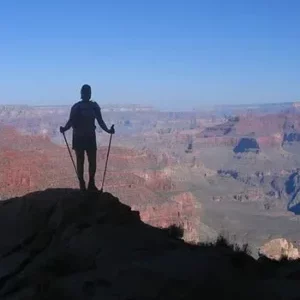 July is a great time to visit the Grand Canyon, but planning a trip yourself can be overwhelming with the large crowds and danger from the severe weather. But you can bypass all that headache by booking a trip with Wildland Trekking. All of our trips are all-inclusive so we will take care of the meals, accommodations, itineraries, local transportation, logistics, and most other things that you can think of. Especially if you want to go backpacking, it is a good idea to go with a guiding company that will provide you with expert guides who have done the trip before and understands how to stay safe. We offer trips in a variety of styles from backpacking and camping tours to inn-based trips and day hikes. Feel free to browse all the trips we offer in the Grand Canyon, but here are a few especially recommend for July.
July is a great time to visit the Grand Canyon, but planning a trip yourself can be overwhelming with the large crowds and danger from the severe weather. But you can bypass all that headache by booking a trip with Wildland Trekking. All of our trips are all-inclusive so we will take care of the meals, accommodations, itineraries, local transportation, logistics, and most other things that you can think of. Especially if you want to go backpacking, it is a good idea to go with a guiding company that will provide you with expert guides who have done the trip before and understands how to stay safe. We offer trips in a variety of styles from backpacking and camping tours to inn-based trips and day hikes. Feel free to browse all the trips we offer in the Grand Canyon, but here are a few especially recommend for July.
Grand Circuit Inn Based: Let yourself relax on this five-day inn-based tour that will take you to many of the distinct sites of the Grand Canyon. Each day, the group will embark on day hikes throughout the park, on both the North and South Rims, before returning in the evening to comfortable lodge accommodations near the rims. You’ll enjoy dinner at the famous El Tovar restaurant along with phenomenal views, fascinating Native American and early settler history, and some of the best hiking in the park.
Havasupai Garden and Plateau Point: This fantastic, three-day summer trip is a great option to get backpacking, but not to overdo it in the heat. Trek down the famous Bright Angel Trail and camp at a centuries-old Native American Garden oasis before coming to plateau point, one of the most sweeping and stunning views in the entire park. You won’t want to miss out on this backpacking adventure, so gear up and get out there.
Phantom Ranch Tour: We can’t say that this is a traditional inn-based tour, but it is an inn-based tour that you will never forget. The much sought-after Phantom Ranch boasting primitive cabins with running water and beds set in a desert oasis is easier to get reservations for in July when the heat at the bottom of the canyon is intense. But on this 2 to 3-day trip, you will get to enjoy this spectacular area and others around it in the canyon along with finding ways to cool off, even if it’s in the creek. With an expert guide and all-inclusive, this trip to the bottom of the canyon and back up is truly remarkable.
South Rim Basecamp Tour: This camping tour gives you all the fun of camping without the intense heat at the bottom of the canyon in the summer. Short enough to do in an extended weekend of three days but long enough to give you a real taste of what the canyon has to offer, this camping trip with spectacular day hikes, wonderful outdoor cooked meals, and some of the best views in the park is great for those wanting to get their feet wet or for national park veterans returning for a relaxed trip to their favorite park.
Join a Guided Hiking Adventure
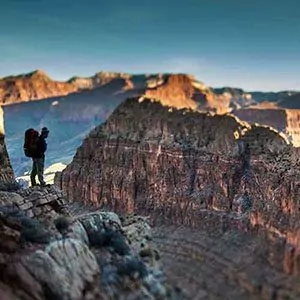 Grand Canyon National Park is home to some of the most unique and spectacular hiking vacations in the world. Wildland Trekking offers trips with stunning views, geologic history, and incredible hiking and backpacking for visitors who want to have an active, adventurous experience.
Grand Canyon National Park is home to some of the most unique and spectacular hiking vacations in the world. Wildland Trekking offers trips with stunning views, geologic history, and incredible hiking and backpacking for visitors who want to have an active, adventurous experience.
Guided Grand Canyon treks include permits, local transportation (excluded on certain tours), meals, gear, risk management systems, and professional guides, allowing guests to make the most of their visit to the Canyon, focus 100% on enjoying their experience, and do it all with an increased level of safety and comfort.
GRAND CANYON ADVENTURE TOURS
- GUIDED BACKPACKING ADVENTURES: these are for people interested in an authentic adventure deep in the Canyon’s wilderness.
- HORSE-ASSISTED TRIP: on this trip to the bottom of the Canyon, guests hike with light day packs and camp near the Colorado River.
- PHANTOM RANCH TOURS: this tour (limited dates) goes to the bottom of the Canyon where we sleep 1 or 2 nights in the Phantom Ranch Lodge 5 minutes from the Colorado River. Showers, A/C, heat…etc.
- ALL-INCLUSIVE HIKING PACKAGES: inn-based and camping-based hiking packages provide all-around hiking experiences of the Grand Canyon.
- DAY HIKE TOURS: maximize your day at Grand Canyon on a fully guided, award-winning hiking tour on one of the Park’s best trails.





